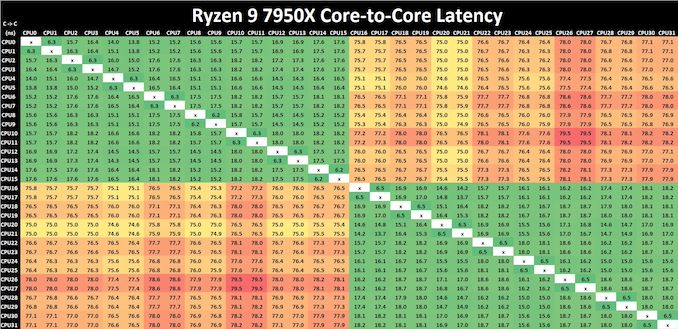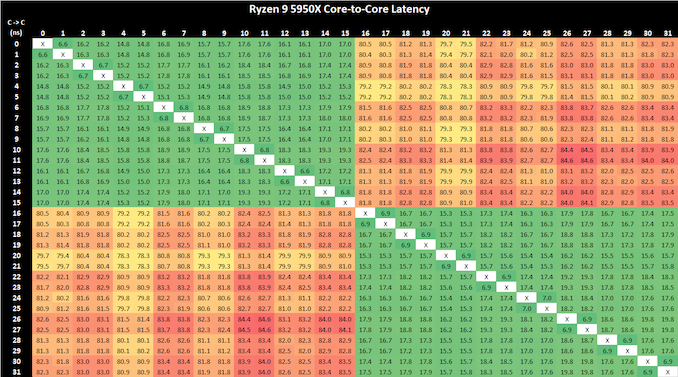AMD Zen 4 Ryzen 9 7950X and Ryzen 5 7600X Review: Retaking The High-End
by Ryan Smith & Gavin Bonshor on September 26, 2022 9:00 AM ESTCore-to-Core Latency
As the core count of modern CPUs is growing, we are reaching a time when the time to access each core from a different core is no longer a constant. Even before the advent of heterogeneous SoC designs, processors built on large rings or meshes can have different latencies to access the nearest core compared to the furthest core. This rings true especially in multi-socket server environments.
But modern CPUs, even desktop and consumer CPUs, can have variable access latency to get to another core. For example, in the first generation Threadripper CPUs, we had four chips on the package, each with 8 threads, and each with a different core-to-core latency depending on if it was on-die or off-die. This gets more complex with products like Lakefield, which has two different communication buses depending on which core is talking to which.
If you are a regular reader of AnandTech’s CPU reviews, you will recognize our Core-to-Core latency test. It’s a great way to show exactly how groups of cores are laid out on the silicon. This is a custom in-house test, and we know there are competing tests out there, but we feel ours is the most accurate to how quick an access between two cores can happen.

Click to enlarge (lots of cores and threads = lots of core pairings)
Comparing core to core latencies from Zen 4 (7950X) and Zen 3 (5950X), both are using a two CCX 8-core chiplet design, which is a marked improvement over the four CCX 16-core design featured on the Zen 2 microarchitecture, the Ryzen 9 3950X. The inter-core latencies within the L3 cache range from between 15 ns and 19 ns. The inter-core latencies between different cores within different parts of the CCD show a larger latency penalty of up to 79.5 ns, which is something AMD should work on going forward, but it's an overall improvement in cross CCX latencies compared to Zen 3. Any gain is still a gain.
Even though AMD has opted for a newer and more 'efficient' IOD which is based on TSMC's 6 nm node. It is around the same size physically as the previous AMD IOD on Zen 3 manufactured on GlobalFoundries 12 nm node, but with a much larger transistor count. Within the IOD is the newly integrated RDNA 2 graphics, although this isn't typical iGPU in the sense that an APU is. A lot of the room on the IOD is made up of the DDR5 memory controller or IMC, as well as the chips PCIe 5.0 lanes, and of course, connects to the logic through its primary interconnect named Infinity Fabric. All of these variables play a part on power, latency, and operation.

AMD Ryzen 9 5950X Core-to-Core Latency results
It's actually astounding how similar the latency performance of the Ryzen 9 7950X (Zen 4) is when compared directly to the Ryzen 9 5950X (Zen 3), despite being on the new 5 nm TSMC manufacturing process. Even with a change of IOD, but with the same interconnect, the inter-core latencies within the Ryzen 9 7950X are great in terms of cores within the same core complex; latency does degrade when pairing up with a core in another chiplet, but this works and AMD's Ryzen 5000 series proved that the overall penalty performance is negatable.










205 Comments
View All Comments
Yirath - Tuesday, October 11, 2022 - link
Well I appreciate the info on the new chip. I am a bit disappointed reading the comments that the chip falls short of it's expectations. As a fan of AMD I'll still probably go with this on my next build. Replyfybyfyby - Tuesday, October 18, 2022 - link
And what shortcomings do you mean? Im fresh user of 7950x and I wouldnt go back to 5900x. 7950X is much more efficient and powerful. Of course now its also investment into new platform. Its not as cheap. And for many people it doesnt make sense. Its absolutely understandable. ReplyVorl - Thursday, October 20, 2022 - link
If this is a rewview of the 7950 and the 7600 why isn't the 7600 in the SPEC tests? Replynamcost - Friday, October 21, 2022 - link
1:1:1 would mean 3000:3000:3000.... The infinity clock doesnt run 3000. So this whole article is factually wrong except the part where you stated that infinity clock was running 2000. That would mean 2000:3000:3000 which is not 1:1:1 at all.... Replynpoc - Wednesday, October 26, 2022 - link
Why doesn't anyone report idle power consumption anymore. I don't care how much power my computer uses when it's running full out because that only happens 1% of the time. 99% of the time my system sits idle waiting to do things. Please report idle power consumption both at the 12v CPU rail, and at the whole system level *(with similarly specced machines, i.e. same nvme, same ram, same GPU, same PSU, similarly specced motherboard). I don't game, but I do have a server that needs upgrading. I honestly care most about how much power this upgrade will cost or save me over my existing i7-4771 (yes that's a thing). Reply